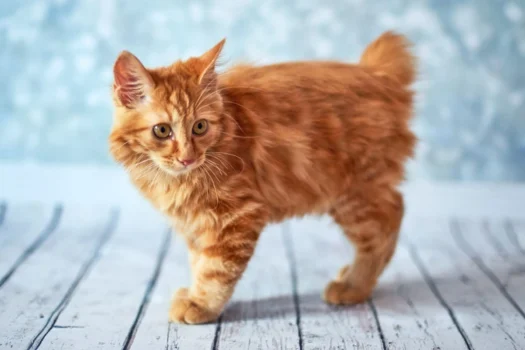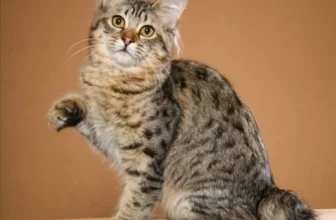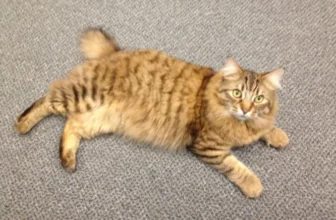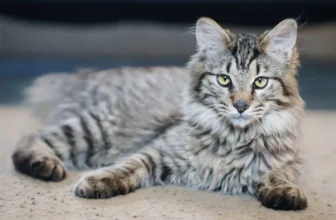They’re playful, they’re affectionate, and they’re a truly unique breed in the world of felines. We’re talking about American Bobtail cats. With their short tails and wild appearance, American Bobtails have become a favorite among cat lovers. But have you ever wondered about the origins of this breed? Who was behind its development and recognition? Join us as we delve into the history of the American Bobtail breed and explore the key figures who were instrumental in its creation. From Jean Mill, the breed’s founder, to the many dedicated breeders who have helped shape its many variations, this article will take you on a journey through the fascinating world of American Bobtail breeding.
History of the American Bobtail Breed
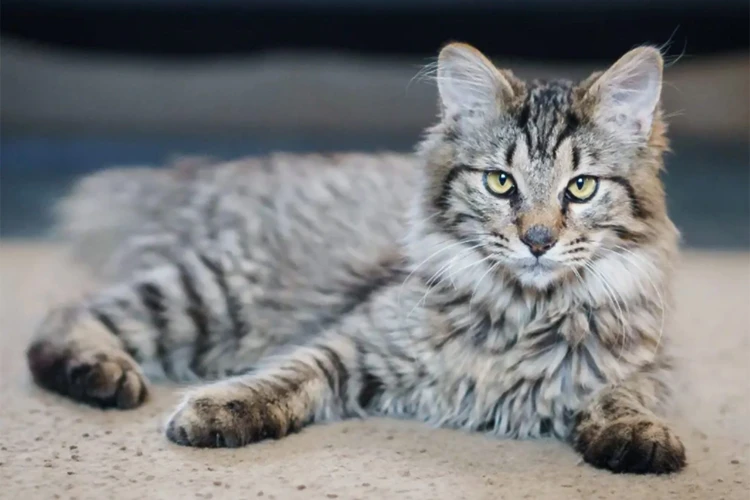
The history of the American Bobtail Breed is a fascinating tale of innovation, determination, and love for cats. From its humble beginnings as a naturally occurring breed to its recognition as a unique and beloved breed, the American Bobtail has captured the hearts of many. In this section, we will delve into the origins of the breed, the challenges faced by breeders, and the evolution of the breed standard. We will also explore the physical and temperament characteristics that make the American Bobtail an exceptional feline companion. So, let’s travel back in time and discover the intriguing history of the American Bobtail Breed together. For more information on American Bobtail breeding history, click here.
The Origins of the American Bobtail Breed
The American Bobtail Breed is an uncommon breed of cat that originated in the United States in the mid-20th century. Its origins are somewhat unclear, but it is believed that the breed developed from a natural genetic mutation which resulted in a shortened tail. Early examples of the breed were found in Arizona and it is thought that the breed may have developed in response to the harsh desert environment.
There are several theories about the origins of the breed, including the possibility that it developed from a cross between a Siamese cat and a bobcat. However, no conclusive evidence has been found to support this theory. Another theory suggests that the breed developed from a cross between a domestic cat and a wild bobcat, although this seems unlikely given the genetic differences between the two species.
Despite its unclear origins, the American Bobtail breed quickly gained popularity among cat fanciers in the United States. In the 1960s, a woman named Jean Mill began breeding American Bobtails in an effort to create a new breed of cat that combined the unique physical characteristics of the breed with a friendly and affectionate temperament. Mill’s efforts were successful, and in 1989, the American Bobtail was officially recognized by the International Cat Association.
Today, the American Bobtail is recognized by several major cat breed registries and is valued for its distinctive appearance and friendly, sociable temperament. The breed has its own standard and has undergone further evolution. You can discover about American Bobtail Breed Standard Evolution and the unique features of bobtail cats in our related articles. However, breeding American Bobtails is not without its challenges: one of the biggest obstacles is ensuring the genetic health of the breed. It’s essential to conduct genetic testing when breeding American Bobtails. Learn more about genetic testing for American Bobtail breeding in our related article Genetic Testing for American Bobtail Breeding.
Despite these challenges, the American Bobtail remains a unique and beloved breed. American Bobtail’s temperament is one of its biggest draws – they are known for being friendly, playful, and affectionate. In short, the American Bobtail is a wonderful breed of cat that has captured the hearts of many cat fanciers.
Breed Recognition and Standardization
The American Bobtail breed was first recognized by The International Cat Association (TICA) in 1989, and later by the American Cat Fanciers Association (ACFA) in 2000. Standardization of the breed ensued, with breeders working together to define and establish the unique characteristics of the breed.
The TICA breed standard:
| Characteristic | Description |
|---|---|
| Body Type | Medium to large size, muscular and athletic, with a natural tail that is conspicuously shorter than the average cat. |
| Head Shape | Broad and modified wedge shape with a gently sloping nose. Cheeks are full and prominent. |
| Ears | Medium to large in size, with lynx tipping preferred. Tuffs at the tips are desirable. |
| Eyes | Large and almond-shaped, set at a slight angle toward the nose. Eye color can vary. |
| Coat | Moderately long and shaggy, with a resilient texture. All patterns and colors are acceptable, including lynx point, tabby, and solid color. |
| Tail | Naturally bobbed, ranging from 1-4 inches in length. The tail should not be kinked, twisted, or curved. |
While TICA and ACFA breed standards are similar, there are slight differences in allowable colors and patterns. The ACFA also allows for polydactylism in their breed standard.
Challenges in Breed Standardization:
While breed standardization is important in maintaining the breed’s unique characteristics, it can also pose challenges for breeders. Breeding for a particular trait can often lead to health issues and inbreeding. Additionally, breeders must work to maintain genetic diversity while adhering to the breed standard.
Another challenge is distinguishing the American Bobtail from other bobtail breeds, such as the Japanese Bobtail and the Pixie-Bob. While these breeds have similar physical characteristics, the American Bobtail is distinguished by its unique temperament and coat texture. It is also important for potential owners to understand the difference between American Bobtails and cats with naturally short tails, such as Manx cats. Here is more information on the topic.
Breed recognition and standardization has allowed the American Bobtail breed to establish itself as a unique and beloved cat breed.
Characteristics of the American Bobtail Breed
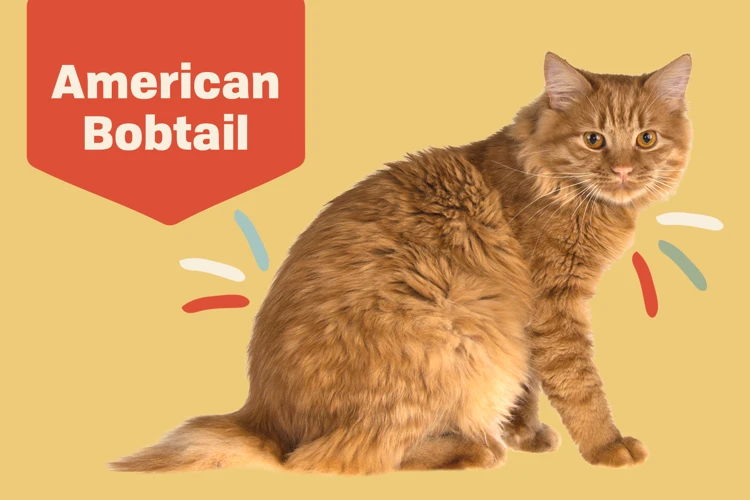
Are you curious about what makes the American Bobtail breed so unique? From their distinctive physical features to their playful temperament, there are many fascinating characteristics that distinguish this breed from others. Let’s explore the standout traits of the American Bobtail and discover why they’ve become a beloved household pet for many families. Get ready to be amazed by these remarkable felines.
Physical Characteristics
The American Bobtail breed is known for its unique physical characteristics that distinguish it from other cat breeds. Below are some of the most notable physical traits of the American Bobtail:
- Body Type: The American Bobtail cat breed is medium to large in size with heavily muscled, athletic bodies that are broader at the shoulders than the hips.
- Tail: The most distinctive physical characteristic of the American Bobtail is its short and stubby tail, which is no longer than one-third of the cat’s body length. The tail is also flexible and sometimes has a curve, kink, or bump.
- Coat: The American Bobtail’s coat is short to medium in length, and can come in a variety of colors and patterns, including tabby, solid, and pointed. The coat is also thick and water-resistant, making it suitable for colder climates.
- Facial Features: American Bobtail cats have a large, broad head with a prominent forehead and strong jawline. They also have round eyes that can be any color, and a wide nose with a slightly concave profile.
- Paws: The American Bobtail’s paws are large and rounded, with thick pads that enable them to walk quietly without making noise. Some American Bobtails also have polydactyl paws, which means they have extra toes.
These physical characteristics have made the American Bobtail a sought-after breed among cat lovers. Though individual American Bobtails may vary in appearance, the breed’s overall physical traits are consistent and unique, setting it apart from other cat breeds.
Temperament
The American Bobtail breed is known for its friendly, sociable, and intelligent temperament. They are affectionate cats who enjoy being around people and other pets. Here are some of the key characteristics of their temperament:
- Playfulness: American Bobtails love to play, and their playful antics can amuse and entertain their owners for hours. Their playful nature also makes them great companions for children.
- Intelligence: These cats are intelligent and curious, and they enjoy exploring their surroundings. They also have great problem-solving skills and can easily adapt to new situations.
- Loyalty: American Bobtails are known for their loyalty to their owners. They form strong bonds with their human companions and can be quite protective of them.
- Adaptability: These cats are adaptable and can adjust to different living situations, including apartments and homes with other pets.
- Independent streak: While they love attention, American Bobtails can also be independent and self-sufficient. They don’t require constant attention but appreciate affection and love to cuddle.
The American Bobtail breed is known for its loving and playful personality, making them great companions for families and individuals alike. They are also adaptable and intelligent, which makes them easy to train and a joy to be around. Whether you’re looking for an affectionate lap cat or an adventurous playmate, the American Bobtail is a breed worth considering.
Key Figures in American Bobtail Breeding
The breeding and development of the American Bobtail breed would not have been possible without the contribution of several notable figures in the cat breeding world. These individuals were instrumental in creating and establishing the breed, each with their unique vision and contributions. Through their tireless efforts and dedication, the American Bobtail has become a beloved and sought-after breed. Let’s take a closer look at some of these key figures and their roles in the breed’s history.
Jean Mill: Founder of the American Bobtail Breed
Jean Mill is considered the founder of the American Bobtail breed. She was a Bengal cat breeder who lived in Riverside, California, and became interested in bobtailed cats in the 1960s. She found a brown tabby kitten with a short tail near an Indian reservation in Arizona and named him Yodi. Yodi was the first American Bobtail and became the foundation cat for the breed.
Table: Some facts about Jean Mill
| Fact | Details |
| Profession | Bengal cat breeder |
| Location | Riverside, California |
| Interest in bobtailed cats | Started in the 1960s |
| First American Bobtail | Yodi, a brown tabby kitten with a short tail |
Jean Mill started breeding American Bobtails in the late 1960s and early 1970s. She used Yodi as the foundation and worked with other breeders who had bobtailed cats to develop the breed. She also introduced new bloodlines to improve the breed’s health and genetic diversity.
Jean Mill’s dedication to the American Bobtail breed helped it gain recognition by major cat associations such as The International Cat Association (TICA) and the Cat Fanciers’ Association (CFA). She was also instrumental in creating the breed standard for the American Bobtail, which outlined the physical and behavioral characteristics that are unique to the breed.
Today, the American Bobtail is a popular breed that is known for its friendly and playful nature. Jean Mill’s pioneering efforts in developing this breed have had a lasting impact on the cat breeding community, and her legacy lives on through the continued breeding and promotion of American Bobtails.
Bobbi California: First Stud Book Keeper
One of the key figures in American Bobtail breeding was Bobbi California, who served as the first stud book keeper for the breed. California played a crucial role in establishing the American Bobtail breed as an officially recognized breed.
The role of a stud book keeper
A stud book keeper is responsible for maintaining detailed records of a breed’s genealogy. This process involves documenting the lineage of each individual cat in the breed, including their parents, grandparents, and great-grandparents. By keeping meticulous records of a breed’s genetic history, stud book keepers can help breeders make informed decisions about which cats to breed in order to produce litters with desirable traits.
Bobbi California’s contributions to the American Bobtail breed
As the first stud book keeper for the American Bobtail breed, Bobbi California played a critical role in the development of the breed. She kept detailed records of each cat’s genetic history and helped to establish a uniform set of breed standards. Her efforts helped to ensure that the American Bobtail breed was recognized as an official breed by cat fancier organizations.
California also served as a significant figure in the breeding community, often providing mentorship, advice, and encouragement to other breeders. She was known for her commitment to the breed, and for her advocacy of ethical breeding practices.
Legacy
Bobbi California’s contributions to the American Bobtail breed have been invaluable, and her legacy is still felt in the breed today. Thanks in large part to her efforts as a stud book keeper, the American Bobtail is now recognized as a distinct and unique breed with a strong and loyal following.
Today, the American Bobtail breed owes a great deal to the pioneering work of Bobbi California and other key figures in the breed’s development. Their efforts have helped to establish the American Bobtail as one of the most beloved and sought-after cat breeds in the world.
Rick and Teresa Weber: Founders of the Longhair American Bobtail
The Longhair American Bobtail is a unique variation of the American Bobtail breed, characterized by its long and soft fur. The development of this sub-breed is credited to the efforts of Rick and Teresa Weber, who dedicated their time and resources to establish the Longhair American Bobtail as a recognized breed.
Rick and Teresa Weber, who are both breeders and exhibitors of cats, first encountered an American Bobtail with long hair in 1993. Intrigued by this unusual feature, they decided to try breeding it with other American Bobtails in the hopes of creating a new breed. In collaboration with Jean Mill, the founder of the American Bobtail Breed, they began a selective breeding program to develop the Longhair American Bobtail.
After numerous trials and errors, they eventually succeeded in developing a breed with the signature long hair and an amicable temperament. The Longhair American Bobtails went on to be recognized as a breed by both The International Cat Association (TICA) and the Cat Fanciers’ Association (CFA).
The Longhair American Bobtail is a medium to large-sized cat with a sturdy build and a tail that is half the length of a regular cat’s tail. It has a friendly disposition and is known to be playful and affectionate towards its owners. Its long and soft fur is a distinguishing feature, which comes in a variety of colors and patterns.
| Longhair American Bobtail Characteristics | |
|---|---|
| Size | Medium to Large |
| Weight | 8-14 pounds |
| Tail Length | Half the length of a regular cat’s tail |
| Coat | Long, Soft, and comes in many colors and patterns |
| Temperament | Friendly, Playful, and Affectionate |
Due to their unique and appealing appearance, Longhair American Bobtails have gained immense popularity among cat lovers. They are relatively low-maintenance cats that require regular grooming due to their long hair. They are intelligent and social, and enjoy interacting with their human companions.
Rick and Teresa Weber’s dedication to developing the Longhair American Bobtail has played a crucial role in expanding the breed’s popularity and recognition. Their efforts have succeeded in creating a new sub-breed of the American Bobtail that is loved and appreciated by many.
Truda and Harold Straede: Founders of the Lynx Point American Bobtail
Truda and Harold Straede are two of the most renowned figures in the world of American Bobtail breeding, having made significant contributions to the development of the Lynx Point American Bobtail. Lynx Point American Bobtails are known for their striking markings, which resemble those of the wild lynx. Here are some interesting facts about the Straedes and their role in the breeding and recognition of the Lynx Point American Bobtail:
- Breeding Inspiration: The Straedes were inspired to create the Lynx Point American Bobtail after seeing a wild lynx in the Cascade Mountains of Washington State. They were fascinated by the lynx’s distinctive markings and wanted to create a breed of cat that resembled it.
- Breeding Efforts: To create the Lynx Point American Bobtail, the Straedes focused on breeding cats with bobtails and tabby markings, as tabbies often have distinctive “M” shapes on their foreheads that resemble the markings of a lynx.
- Breed Recognition: The Lynx Point American Bobtail was officially recognized by The International Cat Association (TICA) in 1998, thanks in large part to the Straedes’ efforts.
- Appearance: Lynx Point American Bobtails are generally medium to large cats with muscular bodies and broad, wedge-shaped heads. Their fur is usually short or medium length, and they have distinctive tabby markings that give them the appearance of a wild lynx.
- Temperament: Lynx Point American Bobtails are known for being friendly and playful, with a strong hunting instinct. They are also highly intelligent and can be trained to do tricks and respond to commands.
Thanks to the Straedes’ tireless efforts, American Bobtail enthusiasts around the world can now enjoy the beauty of the Lynx Point American Bobtail, a breed known for its unique and striking appearance.
Kim Everett: Creator of the Spotted American Bobtail
Kim Everett played a significant role in American Bobtail breeding by creating the Spotted American Bobtail, a rare and unique form of the breed. Her dedication and passion for these cats have made her a respected and well-known figure in the breeding community.
Background: Before Everett began breeding American Bobtails, she had previous experience breeding spotted cats, particularly Egyptian Maus. This experience gave her the knowledge she needed to create a unique and stunning breed of American Bobtails.
Spotted American Bobtail Characteristics: The Spotted American Bobtail is easily distinguishable by its striking coat pattern, featuring bold and contrasting spots against a lighter background. These cats have short, dense coats that are soft to the touch. Their eyes are large, round, and expressive, providing a captivating persona.
Breeding Process: Everett began breeding American Bobtails, particularly those with tabby coats, with the goal of producing a spotted version. Through selective breeding and genetic testing, she was able to produce the first Spotted American Bobtail in 1994. Everett’s breeding program focused on producing healthy and social cats with unique and beautiful coats.
Recognition: The Spotted American Bobtail has received recognition from various cat organizations, including The International Cat Association (TICA), which accepted it as a new breed in 2002. This recognition has helped increase the popularity of the Spotted American Bobtail, making it a sought-after breed for those looking for a unique and beautiful feline companion.
Conclusion: Kim Everett’s dedication to breeding the Spotted American Bobtail has made her a notable figure in the American Bobtail breeding community. Her knowledge of breeding and commitment to producing beautiful and healthy cats has led to the creation of a rare and stunning breed. The Spotted American Bobtail has become a beloved breed for many, thanks to Kim Everett’s passion and devotion to American Bobtail breeding.
Lisa and Dick Kaelin: Founders of the Polydactyl American Bobtail
One unique variation of the American Bobtail breed is the polydactyl trait, where the cats have extra toes on their paws. This trait is credited to Lisa and Dick Kaelin, who are the founders of the Polydactyl American Bobtail.
Lisa and Dick Kaelin, who live in Montana, spent several years developing this variation of the breed. They used cats with the polydactyl trait and bred them with American Bobtails to produce kittens with the trait.
The Kaelins were successful in developing the Polydactyl American Bobtail, which is characterized by a muscular, athletic body type and the signature bobbed tail. Additionally, they have unique patterns and colors, and are known to be friendly, playful, and social cats.
To further understand the characteristics of the Polydactyl American Bobtail, we can refer to the following table:
| Characteristics | Description |
|---|---|
| Body Type | Muscular and athletic |
| Tail | Bobbed, conveys a sense of wildness and naturalness |
| Paws | Polydactyl, with more toes than usual |
| Coat | Varies in length and color, can be short or long-haired |
| Temperament | Friendly, playful, social |
Today, the Polydactyl American Bobtail is recognized as a separate variation by some cat associations. With its unique appearance and friendly personality, it has become a popular pet choice for cat lovers.
Linda and Richard Shorey: Founders of the Rare Solid Color American Bobtail
The American Bobtail breed comes in a wide variety of coat patterns and colors. However, it wasn’t until Linda and Richard Shorey began breeding rare solid color American Bobtails that a new coat pattern was added to the breed’s repertoire. The Shoreys, who are based in Montana, began their breeding program in the late 1990s.
The Shoreys’ Breeding Process
The Shoreys’ breeding process focused on developing the rare solid color American Bobtail. They primarily used breeding pairs that had a solid color parent and a spotted parent, hoping to breed out the spotted pattern to create a solid colored American Bobtail. They also occasionally introduced outside bloodlines with the same goal in mind.
Results of the Shoreys’ Breeding Program
After years of diligent breeding, the Shoreys finally achieved their goal of developing the rare solid color American Bobtail. Their cats have exceptionally thick, plush coats that come in a range of solid colors, including black, white, blue, cream, and red. These cats have the same distinctive bobbed tail and muscular build as their spotted counterparts.
The Importance of the Shoreys’ Contribution
The Shoreys’ breeding program significantly expanded the American Bobtail breed’s color palette. Before their breeding program, the breed was primarily known for its distinctive spotted coat patterns. The Shoreys not only created a new coat pattern but also contributed to the breed’s overall health and pedigree by carefully selecting and breeding their cats. They have established themselves as important and respected figures in American Bobtail breeding.
| The Shoreys’ Breeding Process | |
|---|---|
| Focus | Developing the rare solid color American Bobtail |
| Method | Using breeding pairs that had a solid color parent and a spotted parent, occasionally introducing outside bloodlines with the same goal in mind |
| Results of the Shoreys’ Breeding Program | |
| Coat characteristics | Thick, plush solid-colored coats in black, white, blue, cream, and red |
| Other characteristics | Distinctive bobbed tail and muscular build |
| The Importance of the Shoreys’ Contribution | |
| Contribution | Significantly expanded the American Bobtail breed’s color palette and contributed to the breed’s overall health and pedigree |
Kim Mendoza: Developer of the Curly Coated American Bobtail
Kim Mendoza is a highly respected and well-regarded figure in the American Bobtail breeding community. She is known for developing the Curly Coated American Bobtail, a unique variation of the breed that features a distinctively curly coat that is soft and plush to the touch.
Mendoza’s Curly Coated American Bobtail project began in the early 1990s, when she acquired a male kitten with a curly coat. Intrigued by his unusual appearance, she began to research the genetics behind the curl and experiment with selective breeding to try and produce more kittens with curly coats.
Mendoza’s work paid off, and she soon began to produce litters of Curly Coated American Bobtails with stunningly beautiful and unique coats. These cats quickly gained a following among cat enthusiasts and started to become more popular throughout the United States.
One of the things that sets the Curly Coated American Bobtail apart from other variations of the breed is their soft and curly coat. This curly coat is incredibly touchable, with a plush texture that makes them a favorite among cuddlers and cat lovers alike.
Mendoza’s Curly Coated American Bobtails also have other distinctive physical characteristics, including short, muscular bodies, and large, expressive eyes. They are known for their playful and affectionate temperaments, and they are a popular choice as family pets.
Kim Mendoza’s work in developing the Curly Coated American Bobtail has made a significant contribution to the breed and has helped to make it one of the most popular and widely recognized breeds in the world today.
Janet and Darrell Crane: Founders of the Munchkin American Bobtail
The Munchkin American Bobtail is a unique and adorable breed that owes its existence to the efforts of Janet and Darrell Crane. The Cranes were instrumental in bringing together two breeds, the Munchkin and the American Bobtail, to create a beautiful new hybrid.
Janet and Darrell Crane were passionate breeders who loved both the Munchkin and American Bobtail breeds. They noticed that the Munchkin breed, which is known for its short legs, had a similar body type to the American Bobtail. They saw an opportunity to create a new and exciting breed by combining the two.
The Cranes’ work involved careful breeding and selection to ensure that the Munchkin American Bobtail retained the best characteristics of both parent breeds. They were successful in creating a breed that had the short legs of the Munchkin, the robust body of the American Bobtail, and a friendly, affectionate disposition that made them a favorite among cat lovers everywhere.
The Munchkin American Bobtail has become increasingly popular in recent years, and it’s no surprise why! Their small stature makes them ideal for apartment living, while their friendly and playful personalities make them great companions. It’s all thanks to the hard work and dedication of Janet and Darrell Crane that we can enjoy this wonderful breed today.
Some interesting facts about the Munchkin American Bobtail breed:
- They are known for their short legs, which are caused by a naturally occurring genetic mutation.
- Munchkin American Bobtails are social and love spending time with their human families.
- They have a muscular body and a distinctive bobtail that adds to their unique appearance.
- They come in a wide variety of colors and patterns, from solid colors to tabbies, calicos, and more.
- Their small stature and friendly nature make them a popular choice for families with children and seniors.
Janet and Darrell Crane are true pioneers of the cat breeding world, and their work in creating the Munchkin American Bobtail is a testament to their passion and dedication. Thanks to their efforts, we have a beautiful and unique new breed that brings joy and companionship to cat lovers all over the world.
Conclusion
In conclusion, the American Bobtail breed is a fascinating and beloved breed with a rich history and unique characteristics. From its humble beginnings as a feral cat in the deserts of Arizona to its recognition as an official breed by cat associations worldwide, the American Bobtail has come a long way.
The breed’s physical characteristics, such as their bobbed tails and sturdy builds, make them visually appealing and distinct from other cat breeds. Their friendly and playful temperament also makes them a great addition to any household.
The key figures in American Bobtail breeding, such as Jean Mill, Bobbi California, Rick and Teresa Weber, Truda and Harold Straede, Kim Everett, Lisa and Dick Kaelin, Linda and Richard Shorey, Kim Mendoza, Janet and Darrell Crane, played a crucial role in shaping the breed into what it is today. Their dedication and hard work in maintaining the breed’s integrity and uniqueness have ensured that American Bobtails continue to be a popular and recognizable breed.
Overall, the American Bobtail breed is a testament to the ingenuity and passion of cat breeders who strive to create new and exciting breeds. Its evolution and success are a testament to the human-animal bond and the love and care that people put into their pets. Owning an American Bobtail is an experience like no other, and it’s no wonder that this breed has captured the hearts of so many cat lovers around the world.
Frequently Asked Questions
What is the American Bobtail breed known for?
The American Bobtail breed is known for its short, bumpy tail and wild appearance.
How long has the American Bobtail breed been around?
The American Bobtail breed was developed in the 1960s, making it a relatively new breed compared to others.
What is the origin of the American Bobtail breed?
The American Bobtail breed was originally developed by breeding a short-tailed stray cat to a Siamese cat.
What are the physical characteristics of the American Bobtail breed?
The American Bobtail breed has a muscular and athletic body, a short and bumpy tail, and large, expressive eyes.
What is the temperament of the American Bobtail breed?
The American Bobtail breed is friendly, intelligent, and playful. They are known for being social and affectionate with their owners.
Who is Jean Mill?
Jean Mill is the founder of the American Bobtail breed. She first started breeding the cats in the 1960s.
What is a Lynx Point American Bobtail?
A Lynx Point American Bobtail is a variety of American Bobtail breed that has a distinct pattern of stripes on its fur.
What is a Spotted American Bobtail?
A Spotted American Bobtail is a variety of American Bobtail breed that has a spotted pattern on its fur.
What is a Polydactyl American Bobtail?
A Polydactyl American Bobtail is a variety of American Bobtail breed that has extra toes on its paws.
What is a Curly Coated American Bobtail?
A Curly Coated American Bobtail is a variety of American Bobtail breed that has curly fur. This variation is still in development.

